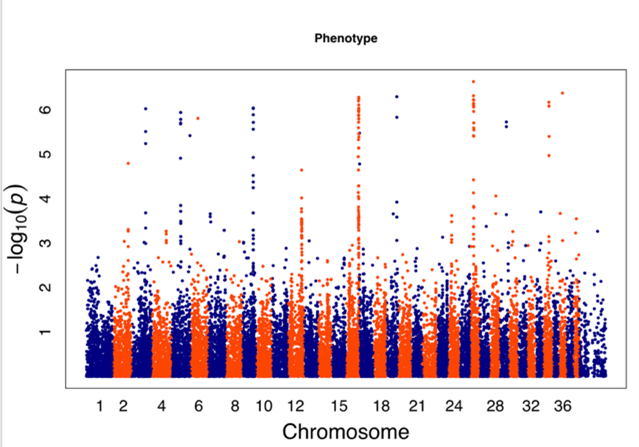UPDATE – EPILEPSY IN THE IRISH WOLFHOUND – OCT. 13, 2021
Margret Casal, Dr med vet, PhD
Clinical Genetics and Advanced Therapies
School of Veterinary Medicine, University of Pennsylvania
Idiopathic epilepsy (IE) has been described in a variety of dog breeds, and a genetic basis has been shown in some. Suggested modes of inheritance included simple such as autosomal recessive with or without a sex-modifier, or complex, such as polygenic with or without a large contribution by a single autosomal recessive gene, or multiple genes at once. Prevalence rates of IE in different breeds have been reported to be between 0.5-5.7%. However, our studies have shown IE to be of significantly higher concern in Irish Wolfhounds (IWH) with of up to 22% affected dogs in a cohort of >1000 dogs. Our study aims at identifying gene(s) involved in epilepsy. To date, we have performed a genome wide association study (GWAS) using 99 IWH samples, 36 of which were seizure dogs (see figure 1). 
Each dot on this graph, called a Manhattan plot because of its peaks, represents an association between an affected dog and a location on the genome. The two different colors are only there to discern between the different chromosomes (blue: chromosome 1, red: 2; blue: 3; red: 4, etc). Thus, the higher the peak, the more affected dogs in that location. Ideally, you would like to see a single peak, which would point you to the location of the area of a chromosome that houses the culprit gene. This Manhattan plot is very “noisy” and does not have a nice clean single signal (peak). At the time we performed this GWAS, the chips that were used only had 42,000 SNPs (sites on the DNA) and of these, only about 27,000 gave us usable information. We then spent a significant amount of time with a biostatistician refining the analysis until we found a more significant signal on chromosome 4.

There were still other peaks on the plot but the location on chromosome 16 seemed to be the most prominent one. By comparison to humans and other species, this region of DNA contained a gene that had to do with neurological development. We sequenced the entire gene, which is very large at >92,000 base pairs. To put this in perspective, imagine that each base pair is a glass bead and there are 4 colors. There are 92,000 of these glass beads strung up in a very specific order and you are trying to find one bead that has the wrong color or is out of place. We found no variations that could explain epilepsy. We then went on to whole genome sequence (2.5 billion base pairs!) an affected IWH and his producer father and could not find obvious variations associated with epilepsy (2.5 billion base pairs). After discussions with our biostatistician, we concluded that we need more samples from affected and normal dogs to perform another GWAS. This will make the power of the study much more significant. In addition, the chips that we can use now are far superior to the previous ones (Illumina chip with 170,000 SNPs). We are of the firm belief that another at least 30 – 50 samples from affected IWHs and 50-70 samples from control dogs (making up 96 samples in total) will be sufficient to locate a gene/genes associated with IE in the IWH.


